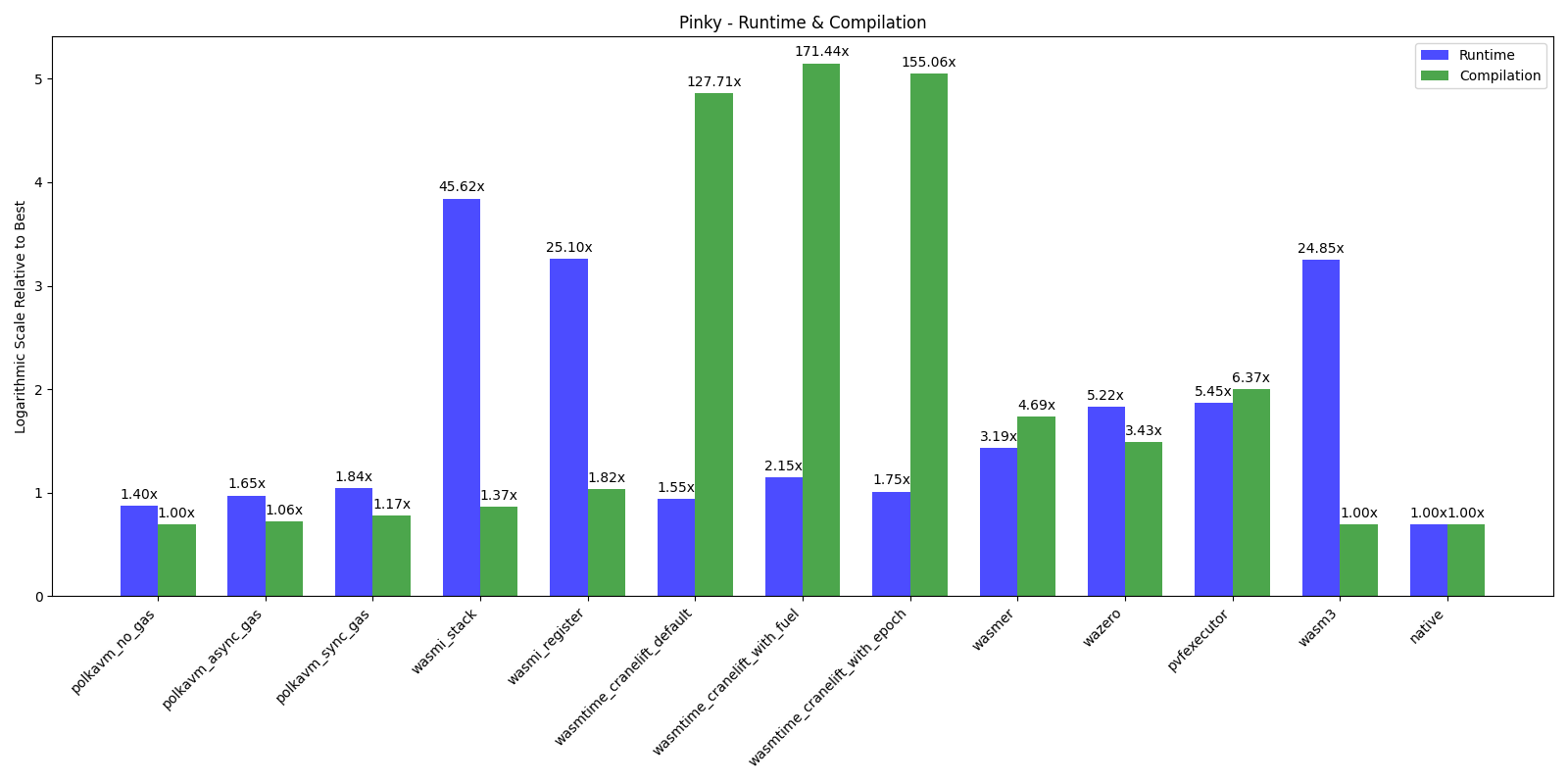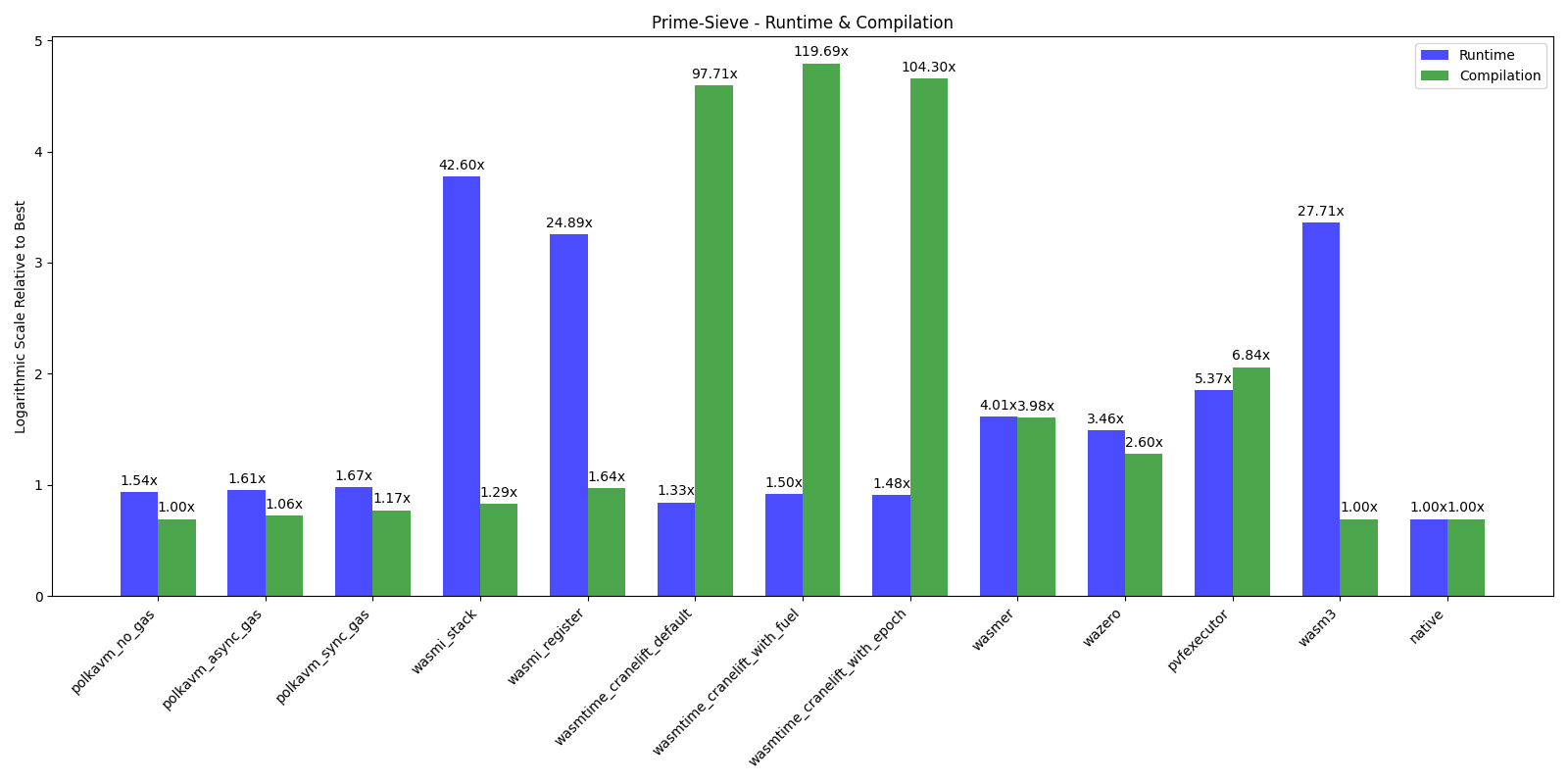
Exploring PolkaVM
Posted on Tuesday, 12 December 2023Suggest An EditTable of Contents
- PolkaVM - A High-Performance RISC-V Based VM
- Introduction
- Background on Polkadot and WASM
- Why RISC-V for PolkaVM?
- Challenges with WebAssembly
- PolkaVM’s RISC-V Based Solution
- PolkaVM’s Quick Development and Performance
- Key Aspects Contributing to PolkaVM’s Speed
- Current Status and Future Outlook of PolkaVM
- But does it really run doom?
A deep dive into the innovative RISC-V based virtual machine revolutionizing smart contract execution in the Polkadot ecosystem. This article delves into its challenges with WebAssembly, superiority of the RISC-V architecture, and impressive capabilities demonstrated by running DOOM. It provides an insightful analysis of PolkaVM’s design, efficiency, and future developments, marking a significant leap in blockchain technology.
PolkaVM - A High-Performance RISC-V Based VM
Introduction
In the rapidly evolving blockchain ecosystem, Polkadot has introduced PolkaVM, a cutting-edge virtual machine based on the RISC-V architecture. This post delves into the technical aspects of PolkaVM, highlighting its design choices that contribute to its remarkable speed and efficiency.
Background on Polkadot and WASM
Polkadot’s initial alignment with WebAssembly (WASM) was instrumental in shaping its blockchain functionalities. However, WASM’s growing complexity and inherent non-determinism posed significant challenges, prompting the need for an alternative solution.
Why RISC-V for PolkaVM?
RISC-V was chosen for its simplicity, stability, and ease of implementation on real hardware. Its portability and standardized design make it an ideal choice for a virtual machine aimed at long-term viability in the blockchain sector.
Challenges with WebAssembly
-
Complexity and Growing Instruction Set: WASM’s evolution has led to a substantial increase in its complexity. From a minimal viable product with 172 instructions, it has expanded to over 400, and with current proposals, up to 541. This complexity contrasts sharply with the simpler 64-bit x86 architecture, which has around 2,000 instructions. The rapid and often unexpected adoption of new instructions in compilers, like the sign extension instructions in LLVM, presents challenges for blockchain developers.
-
Lack of Determinism: For blockchain applications, 100% determinism is crucial. However, WASM does not fully meet this requirement. Issues such as unspecified bit patterns in floating-point NaN (Not a Number) values and an unlimited program stack pose risks of non-deterministic behavior, which is problematic for blockchain applications.
-
Inefficiency of Stack Machine Architecture: WASM is inherently a stack machine, whereas real hardware operates more efficiently as a register machine. The translation from stack to register machine is complex and often leads to inefficient execution and JIT (Just-In-Time) compilation times.
PolkaVM’s RISC-V Based Solution
-
Simplified and Stable Instruction Set: PolkaVM leverages the RISC-V architecture known for its simplicity and stable baseline. Unlike WASM, RISC-V’s instruction set is not prone to rapid or unpredictable expansions, making it more manageable and predictable for blockchain development.
-
Enhanced Efficiency: The RISC-V architecture aligns more closely with real hardware, being a register machine. This alignment significantly reduces the complexity involved in executing programs, leading to faster execution and JIT compilation times.
-
Determinism and Security: PolkaVM addresses the non-determinism issue by ensuring 100% deterministic execution, a fundamental requirement for blockchain applications. Additionally, the security and sandboxing features of PolkaVM provide a more robust environment for running blockchain applications.
-
Rapid Development and Performance: The development of PolkaVM’s initial prototype in just two days, and its subsequent performance outpacing some existing production VMs, demonstrates its efficiency and potential in blockchain technology.
PolkaVM’s Quick Development and Performance
The first prototype of PolkaVM, a JIT recompiler translating RISC-V code to native code, was developed within just two days, showcasing not only rapid development but also superior performance compared to some existing VMs. RISC-V being extremely simple ISA plays a role here.

Key Aspects Contributing to PolkaVM’s Speed
-
Simplified Architecture (RV32e): PolkaVM leverages the RV32e architecture, which has fewer registers, allowing for efficient mapping to the x86 architecture. This simplification reduces the need for memory spilling and enhances execution speed.
-
Custom ELF Sandbox: By ensuring a free lower four gigabytes in the address space, PolkaVM enables efficient single-instruction memory accesses. This approach is significantly faster than the complex memory access methods used by other VMs.
-
Optimized Compilation Pipeline: PolkaVM uses standard toolchains and a unique linker that post-processes ELF files. This results in optimized code generation, macro-op fusion, and other enhancements, significantly reducing the runtime complexity.
-
Efficient Gas Metering: The implementation of both synchronous and asynchronous gas metering methods contributes to the VM’s efficiency, particularly in the context of smart contracts.
-
Security and Sandboxing: Running guest programs in isolated processes and namespaces, similar to Docker containers, enhances security and prevents potential exploits.
-
Runs DOOM: PolkaVM’s ability to run DOOM, a popular first-person shooter game, demonstrates its speed and efficiency. DOOM is also in PolkaVM’s CI pipeline to ensure it runs after every commit.

Current Status and Future Outlook of PolkaVM
PolkaVM currently stands at a pivotal point of nearing production readiness, showcasing impressive strides in achieving execution performance that closely rivals native execution. This remarkable progress is primarily due to the platform’s innovative approach to memory access and compilation. PolkaVM utilizes a unique memory access technique that drastically reduces the complexity and number of instructions required for single instruction memory accesses, thereby enhancing speed and efficiency. This approach is evident in the comparison with Wasmtime, where PolkaVM achieves what Wasmtime does with significantly fewer and less complex instructions.
A critical component of PolkaVM’s efficiency is its compilation pipeline. Unlike traditional virtual machines (VMs) that directly load compiler outputs, PolkaVM employs a standard toolchain (RustC, Clang, GCC) to compile programs into standard ELF files. These files then undergo post-processing by a custom linker, which performs various optimizations such as relocations, macro-op fusion, extra inlining, constant propagation, and dead code elimination. This process shifts the computational burden from the VM to the linker, simplifying the VM’s architecture and enhancing performance.
Looking ahead, PolkaVM’s roadmap is ambitious and forward-thinking. Key future enhancements include:
-
Expanded RISC-V Extension Support: PolkaVM plans to broaden its compatibility with various RISC-V extensions, moving beyond the current MX extension to incorporate extensions like the ratified bit manipulation extensions and the T-head extensions.
-
64-bit Compatibility: The platform aims to evolve from its current 32-bit architecture to support 64-bit processing, a critical step for advanced computing needs.
-
Advanced Gas Cost Models: Research is underway to develop more accurate gas cost models that reflect the workings of modern CPUs. This could lead to more efficient and lower gas fees.
-
Dynamic Features: The introduction of dynamic linking of multiple programs at runtime and time travel debugging (allowing backward as well as forward debugging) is on the horizon. These features, particularly the latter, leverage PolkaVM’s deterministic nature to offer unique debugging capabilities not commonly found in other VMs.
-
CPU Architecture Support Expansion: Plans include extending support beyond 64-bit x86 to embrace platforms like 64-bit ARM, including M1 Apple Silicon chips, and native RISC-V hardware, anticipating future advancements in RISC-V server performance.
-
Comprehensive VM Specification: Before reaching version 1.0, PolkaVM intends to establish a detailed specification with an independent comprehensive test suite. This will facilitate the development of new, fully compatible VMs by third parties, ensuring long-term support and stability.
In summary, PolkaVM is rapidly evolving towards a state of production readiness, with a strong focus on performance, efficiency, and future-proofing through comprehensive planning and innovative technological advancements.
But does it really run doom?
Well in crypto we do not trust but we verify. So we forked the koute/polkavm repo and decided to ran doom ourselves. You can watch the video of the process including introduction to polkavm-disassembler-gui tool.